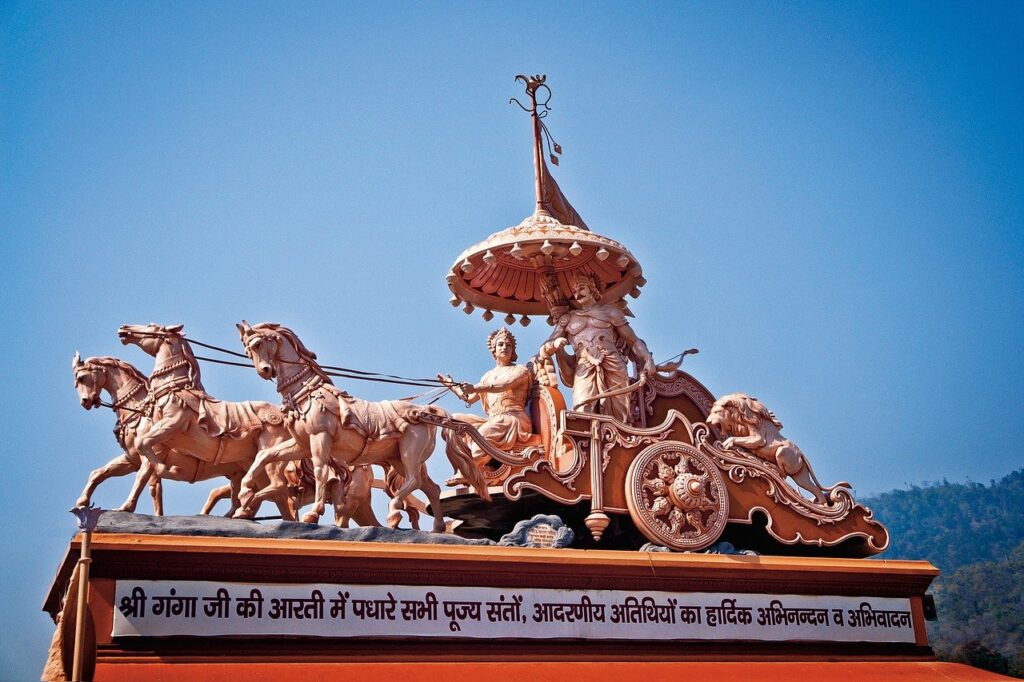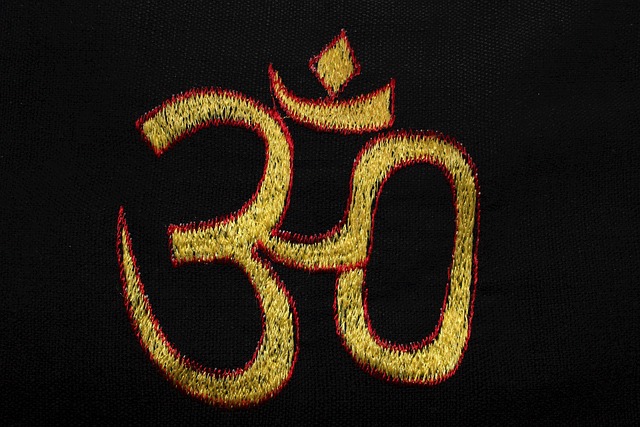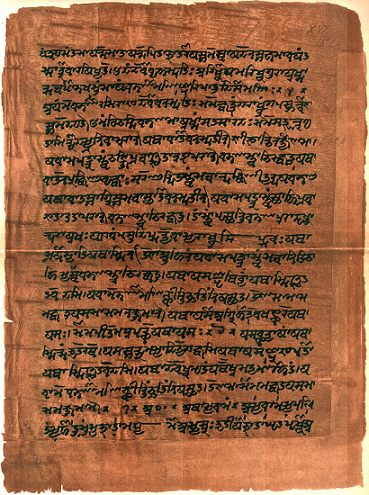
Hinduism, also referred to as ‘Sanatan Dharma’ embodies the eternal duty of seeking our spiritual identity and living in alignment with our divine essence. Rooted in the ancient Vedas, the Vedic philosophy serves as a guiding light to unravel the mysteries of our existence and comprehend the purpose of life. These profound teachings, akin to a comprehensive manual, offer invaluable insights for all seekers on the path.
The terms ‘Hinduism’ and ‘Sanatan Dharma’ are frequently used interchangeably in contemporary times. Nonetheless, let us delve into the genesis of these designations. The naming of the people and their religion as Hindu and Hinduism, respectively, is commonly attributed to the Persians who invaded India during the 6th century B.C. and mistakenly pronounced the S in Sindhu as H. As a result, the term Hindu became a misnomer since it does not represent the diverse range of schools of thought and beliefs encompassed within the religion. Dr. Radhakrishnan has noted that the name Hindu was derived from the fact that the original founders and earliest followers of the civilization inhabited the region drained by the Sindhu river system, as recorded in the oldest Veda, the Rig Veda. This suggests that Hinduism is not a religion or theocracy, but a geographical name for a people, which could include various communities, rites, and gods. Therefore, the Sanskrit term Sanatan dharma is a more appropriate term since it reflects the timeless, universal principles that are the foundation of the Vedic way of life. The Vedic system, based on Hinduism or Sanatan dharma, accommodates diverse communities, rituals, and practices, making it a comprehensive spiritual path that embraces all beings.
Ten Universal Principles of Hinduism :
#1 Realizing the Supreme Being: Bhagavan or God, the timeless, all-encompassing Absolute Truth, manifests in various forms. Although sages may refer to the Supreme by different names, there is but one source and foundation of everything. God is the embodiment of eternal knowledge, bliss, and beauty, permeating all realms.
#2 Embracing the Wisdom of the Vedas: The Vedic literature serves as the bedrock of spiritual knowledge, providing guidance on our true nature and the purpose of life. Composed by enlightened sages and divinely revealed truths, these sacred texts encompass the Rig, Sama, Yajur, and Atharva Vedas, Upanishads, Bhagavad gita, and more, illuminating the path of Sanatan Dharma.

#3 Divine Manifestations: God incarnates throughout history, both in physical forms and as the resonating sound vibrations within scriptures. The ten avatars of God and their multifarious expansions play pivotal roles in the cosmic play of creation.
#4 Awakening the Eternal Self: Each individual is an eternal spiritual soul, jiva, transcending the limitations of the material body. Recognizing our true identity forms the foundation of our spiritual journey.
#5 Law of Karma: Every soul experiences the consequences of their actions through the law of cause and effect. Our thoughts, words, and deeds shape our destiny, and we are bound by the cycle of birth and death until we attain liberation.
#6 Reincarnation: Souls traverse the path of rebirth, directed by their karma. Through successive incarnations, spiritual growth leads to liberation from the cycle of birth and death, enabling the soul to attain its natural position in the spiritual realm.

#7 Worship and Devotion: Engaging in devotional practices, such as deity worship, kindles spiritual elevation and deepens our connection with the Divine.
#8 The Role of the Guru: An authentic spiritual guide, representing an authorized parampara (lineage), provides invaluable instructions on following the Vedic teachings, enabling seekers to progress on their spiritual path.
#9 Principles for Spiritual Development: Adhering to principles such as non-violence (ahimsa) and truthfulness (satya), austerity, cleanliness, etc nurtures our spiritual growth and moral character.
#10 The Four Goals of Life: Life unfolds through four stages (ashramas), beginning with dharma (moral and spiritual development), followed by artha (material prosperity), kama (fulfillment of desires), and culminating in moksha (self-realization and liberation from the cycle of birth and death).
Embracing Hinduism : A Path to Unity, Liberation, and Spiritual Evolution
Hinduism (Sanatan Dharma), far beyond a mere religion, encapsulates a profound philosophy that serves as the very foundation and guiding force for our existence. It beckons us to embrace a way of life that transcends boundaries and illuminates the path to self-realization.
Central to the Vedic tradition is the recognition of the eternal nature of the individual soul. This acknowledgment underscores the universality of spiritual truths and emphasizes the inherent spiritual equality and sanctity of all living beings. Within the tapestry of creation, each soul is an integral part of a greater whole, deserving of respect and reverence.

The principle of Vasudhaiva Kutumbakam, encapsulated within Sanatan Dharma, echoes this notion of unity and oneness. It teaches us that all beings in the vast expanse of the universe are interconnected, forming one global family. This principle compels us to embrace a profound sense of respect and compassion for every living entity, realizing that the essence of the Supreme dwells within each and every one of us.
At the core of Sanatan Dharma lies the ultimate goal of attaining moksha, liberation from the cycle of birth and death and the confines of material existence. It is the culmination of human life, enabling the soul to transcend the limitations of the temporal realm and reunite with its true nature and the transcendental abode. Moksha unveils the eternal bliss and unending love that lie dormant within us, leading us back to our spiritual home.
Sanatan Dharma champions the fundamental freedom of spiritual choice. It recognizes that every individual possesses the inherent right to embark on their unique path of spiritual understanding and growth. Free from external pressures, coercion, or commercial inducement, one is empowered to explore and embrace the spiritual practices and teachings that resonate with their heart and soul. The diversity of paths within Sanatan Dharma serves as a testament to the richness and inclusivity of this ancient tradition.

The Vedic path not only imparts profound spiritual wisdom but also fosters a harmonious coexistence with all life forms. It instills in us an unwavering appreciation for the value and sanctity of every living entity, reminding us of our shared responsibility to care for and nurture the world around us. The Vedic teachings guide us towards a life of peace, compassion, and ecological harmony, fostering a deep reverence for all beings and our interconnectedness with nature.
Embedded within Sanatan Dharma are the moral and ethical virtues that shape our character and facilitate our spiritual evolution. The tenfold qualities of fortitude, forgiveness, self-control, truthfulness, and others provide a moral compass to navigate the complexities of life. By embodying these virtues, we cultivate inner strength, foster harmonious relationships, and elevate our consciousness to higher realms of spiritual understanding.
In embracing Sanatan Dharma as a way of life, we embark on a profound journey of self-discovery and spiritual growth. It offers us a profound philosophy, a holistic worldview that encompasses all aspects of human existence. Through its teachings, we are reminded of our eternal connection with the Supreme and are empowered to realize our true nature and purpose. It is a timeless path that guides us toward self-realization, enabling us to transcend the material realm and bask in the eternal radiance of divine consciousness. Sanatan Dharma beckons us to embrace its wisdom, experience its transformative power, and ultimately find unity, peace, and fulfillment in our lives.
Hinduism welcomes individuals from any background to embrace its teachings, as it is a non-sectarian belief system. A person identifying as Hindu may choose to adhere to all the principles outlined or as many as they find feasible. Becoming a follower of Hinduism is not dependent on joining an institution; rather, it stems from the heartfelt acceptance of its principles and the adoption of associated practices. Optionally, one may seek formal initiation from a Hindu guru or spiritual master, which involves participating in a ritual to be recognized as a qualified follower on the Vedic path.
The Path of Yoga
Bhagavad Gita, a profound scripture, offers valuable insights into various types of yoga that can perfect one’s life. Karma Yoga advocates selfless action, freeing oneself from selfish desires and linking activities to a higher purpose. Jnana Yoga involves philosophical inquiry and intellectual discernment to comprehend the distinction between matter and spirit, ultimately leading to liberation. Bhakti Yoga, considered the epitome of devotion, nurtures an intimate relationship with the Supreme through unwavering love and service.
Bhakti Yoga, often regarded as the synthesis of karma and jnana, emerges as a path that combines external worship, inner development, and the pursuit of spiritual knowledge. While bhakti may initially appear simplistic, it progressively encompasses the essence of all yogic paths. Devotees engaged in pure, selfless service experience liberation from material designations and find profound joy and fulfillment in their relationship with the Supreme.

Beyond the physical and intellectual aspects of yoga, its essence lies in love. Vedic texts emphasize that yoga extends far beyond physical healing or mental tranquility. True yoga fulfills our deepest longing for love and connection. Love, often misunderstood as solely a physical or emotional bond, transcends these limitations. It enables us to establish eternal connections by centering our relationships on the Supreme, the source of all love.
In our pursuit of yoga, let us explore not only the external practices and philosophical aspects but also dive deep into the ocean of divine love. Through our yoga journey, may we find the fulfillment and eternal connection our hearts truly desire.
Sacred Texts of Hinduism
In general, those who adhere to the principles prescribed in the Vedas and their related texts are referred to as Hindus or ” Sanatan Dharmis”. The term ‘Veda’ denotes knowledge, and these ancient scriptures are believed to have been divinely revealed. They are considered to be a desire tree, containing all possible knowledge accessible to humans, and encompass a wide range of topics, from the worldly to the spiritual. The religious texts of Hinduism can be classified into two main categories: Shruti, which means “that which is heard” and is considered to be authoritative, eternal, and a revelation of undeniable truth; and Smriti, which means “that which is remembered” and is considered to be supplementary to Shruti. Shruti includes the four Vedas, Upanishads, and other sacred texts, while Smriti includes Itihasas, Puranas, and other related texts. Below are the principal Vedic Texts –
#1 The Four Vedas – The Rig Veda, Sama Veda, and Yajur Veda are collectively known as Vedatrayi. Atharva Veda is considered a later addition. Bharat Muni’s Natya Shastra is deemed to be the fifth Veda. The Rig Veda is the oldest among all the other Vedas.
Rig veda – It is the oldest of the Vedas and is divided into ten books (mandalas) and has 1028 hymns praising the various deities. These include Agni, Vishnu, Rudra, Varuna, and other early Vedic gods. It also contains the famous ‘Gayatri mantra’ and the ‘Purusha Shukta’ prayer (10.7.90.1-16).

Yajur Veda – A priestly handbook for use in the performance of yajnas (sacrifices).
Sama Veda – This consists of chants and melodies to be sung during worship and the performance of yajna.
Atharva Veda – Contains hymns, mantras, and chants, largely outside the scope of yajna.

#2 108 Upanishads – The term ‘Upanishad’ means an intimate session between the teacher and the taught. The Upanishads contain the philosophical essence of the Vedas and are therefore called Vedanta. ‘Veda’ means knowledge, and ‘anta’ means the end. In other words, proper understanding of the ultimate meaning of the Vedas is called Vedanta knowledge. Among the 108 Upanishads, the below are considered topmost :
- Isa
- Kena
- katha
- Prasna
- Mundaka
- Mandukya
- Taittiriya
- Aitareya
- Chandogya
- Brihad-aranyaka
- Svetasvatara
#3 Vedanta Sutra – The Vedanta Sutras (also called the Brahma Sutras) are composed by sage Vyasa to systematize the teachings of the Upanishads. There are a total of 550 aphorisms divided between four chapters.
#4 Itihasas (epics) – Comprises two epics : Ramayana (composed by sage Valmiki) and Mahabharata (composed by Veda Vyasa). Mahabharata also includes the all popular Bhagavad Gita.
#5 Bhagavad Gita – Instructions spoken by Lord Krishna to Arjuna, the great warrior, on the battlefield of Kurukshetra. These instructions on life and spirituality are enlightening and can deliver one from the ocean of material existence.
#6 Puranas (history) – Puranas are compiled from related historical facts which explain the teachings of the four Vedas. There are primarily 18 Puranas –
- Vishnu Purana
- Naradiya Purana
- Padma Purana
- Garuda Purana
- Varaha Purana
- Bhagavata Purana
- Matsya Purana
- Kurma Purana
- Linga Purana
- Shiva Purana
- Skanda Purana
- Agni Purana
- Brahmanda Purana
- Brahma Vaivarta Purana
- Markandeya Purana
- Bhavishya Purana
- Vamana Purana
- Brahma Purana
#7 Dharma Shastra (law books) – The Dharma Shastras include the law codes of Sanatan Dharma. They deal with three main subjects: codes of conduct, civil and criminal law, and punishment and atonement. The most important of them is Manu Smriti (or Manu Samhita), which is still consulted in Indian law. It was written by Manu, an administrative demigod (the “ruler of mankind”) and the first law-giver. The word “man” is said to derive from Manu. Closely related is the ArthaShastra, a text that delves into the science of acquiring wealth and power.
#8 Vedangas – auxiliary science related with Vedic study such as astronomy, astrology and phonetics.
#9 Upavedas – These are sciences not directly related to Vedic study. They are : Dhanurveda (deals with the art of warfare), Gandharvaveda (deals with the music), Silpaveda (deals with art and architecture) and Ayurveda (deals with medicine).
#10 Sectarian texts (e.g. agamas, tantras) – deals with ritualistic practices, and includes the Vaishnava Pancharatra, Shaiva Agamas and Tantras, and the Shakta Devi Shastra.
#11 Vernacular literature – Many subsidiary vedic texts, particularly during the medieval period, are written in local vernaculars such as Bengali, Tamil, Brijbasi, Gujarati, etc